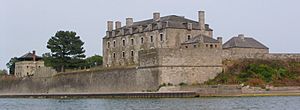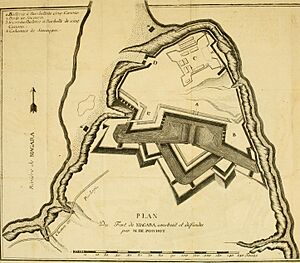Battle of Fort Niagara facts for kids
Quick facts for kids Battle of Fort Niagara |
|||||||
|---|---|---|---|---|---|---|---|
| Part of the French and Indian War | |||||||
 Fort Niagara |
|||||||
|
|||||||
| Belligerents | |||||||
| Iroquois | |||||||
| Commanders and leaders | |||||||
| Pierre Pouchot (POW) Daniel-Marie Chabert de Joncaire de Clausonne |
John Prideaux † William Johnson Sayenqueraghta |
||||||
| Strength | |||||||
| 1,786 (Regulars, Canadians and Native Americans) | 2,000 regulars 1,000 militia 945 Iroquois |
||||||
| Casualties and losses | |||||||
| 109 killed or wounded 377 captured |
239 killed or wounded | ||||||
The Battle of Fort Niagara was a major event during the French and Indian War. This war was the North American part of a bigger worldwide conflict called the Seven Years' War. In July 1759, British forces surrounded and attacked Fort Niagara. Their goal was to take control of the Great Lakes and Ohio Valley areas from the French. This victory would also help the British invade the French province of Canada from the west. This attack was planned to happen at the same time as General James Wolfe's invasion from the east.
Contents
Why Fort Niagara Was Important
British General Jeffery Amherst planned military actions for 1759. One key goal was to capture Fort Niagara. This fort was a very important French military and supply base. It connected French Canada with their forts in the Ohio Valley.
General Amherst chose Brigadier General John Prideaux to lead the attack. Sir William Johnson also joined the expedition. He was a British agent who worked with Native Americans. He led the Iroquois forces who fought alongside the British.
French Preparations at Fort Niagara
Captain Pierre Pouchot of the French Army had mostly built Fort Niagara. In early 1759, French leaders sent him about 2,500 more men to make the fort stronger. However, Captain Pouchot later sent many of these men south to Fort Machault. This was part of a plan to strengthen other French forts and attack the British at Fort Pitt.
The soldiers left to defend Fort Niagara were about 200 regular French troops. There were also 20 artillerymen and about 300 local volunteer soldiers and militia.
The British March to Niagara
General Prideaux's British troops included soldiers from the 44th and 46th Regiments. They also had two companies from the 60th Regiment, totaling about 2,200 men. He also commanded 2,500 local volunteer soldiers from New York. Another 700 volunteers came from Rhode Island.
The expedition was delayed because of high water on the Mohawk River. Some volunteer companies also arrived late. The army finally started leaving Schenectady in mid-May. On June 27, they reached Fort Oswego. Here, Sir William Johnson and about 600 Iroquois warriors joined them.
The Siege of Fort Niagara
After leaving some men to guard Fort Oswego, Prideaux set off for Niagara on July 1. He had about 3,200 men. The French had ships patrolling Lake Ontario to spot British movements. But one French crew was not paying attention. This allowed the British group of boats to arrive without being seen.
The British landed near a swamp on July 6, out of sight of the fort. They immediately began trying to capture the fort.
The Defense and a Change in Command
The French had about 100 Iroquois allies at the fort. These allies left to meet with the Iroquois who were with the British. Captain Pouchot led a strong defense of the fort.
During the siege, General Prideaux was killed. A piece of a cannonball from one of his own guns hit him. Command of the British forces then went to Sir William Johnson. Johnson was a provincial officer, meaning he was not part of the regular British army. This raised some questions about his right to lead. But Sir William had a special royal commission as commander of the Iroquois helpers. So, he insisted on staying in command even when a lower-ranking regular army officer arrived.
French Surrender
The French surrendered on July 26. This happened after a French relief force, trying to help the fort, was defeated. This battle took place at the Battle of La Belle-Famille, about two miles south of the fort.
What Happened Next
The surrender of Fort Niagara happened on the same day that French troops left Fort Carillon (later called Fort Ticonderoga). This fort was abandoned because a huge British army under General Amherst was approaching.
After Fort Niagara was captured, the French left other forts on the frontier. They called their soldiers back to defend the main populated areas of Canada. Forts abandoned by the French included Fort Saint-Frédéric (in modern-day Crown Point) and Fort Rouillé (in modern-day Toronto). Fort St. Frédéric was destroyed by the French as they left Lake Champlain to protect the heart of Canada. The soldiers at Fort Rouillé were told to leave the area and burn the fort if Fort Niagara fell. After the British captured Fort Niagara, the French soldiers burned Fort Rouillé and went back to Montreal. The remaining French forts in the Ohio and Illinois Country were eventually given to the British.
In the same month, General Montcalm led the defense against British General James Wolfe at Quebec City. This siege lasted three months. The capital city was taken in September 1759 at the Battle of the Plains of Abraham. The next year, the French tried to recapture Quebec City. However, their attempts failed when British reinforcements arrived. A year later, after a two-month campaign, Montreal was conquered by the British in September 1760. The French leaders in New France signed the Articles of Capitulation. This document surrendered the colony of Canada to the British. This signing marked the end of major fighting in North America during the Seven Years' War.
Images for kids
See also
 In Spanish: Batalla de Fort Niagara para niños
In Spanish: Batalla de Fort Niagara para niños



